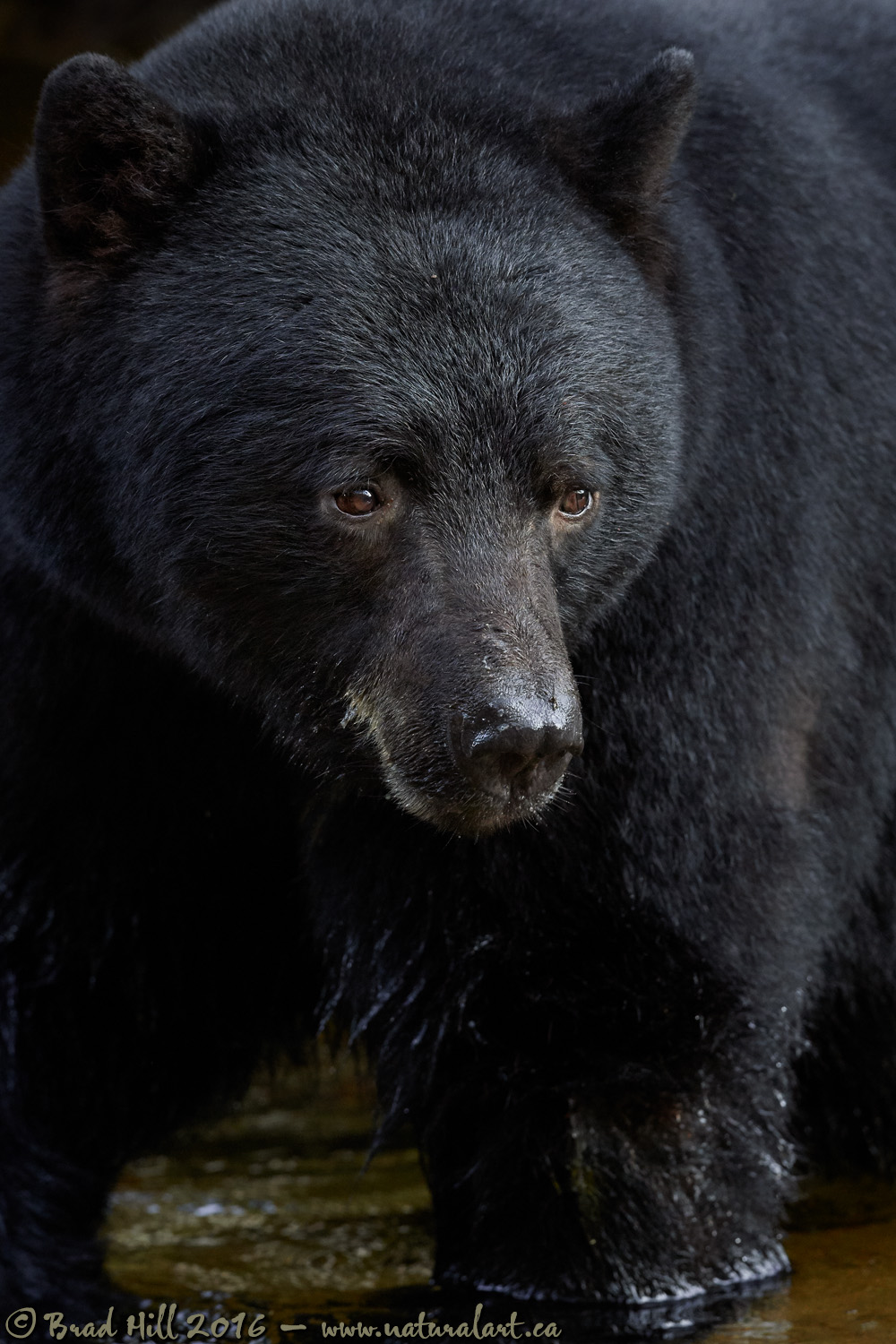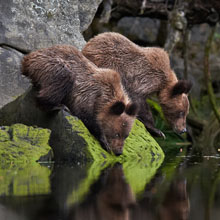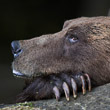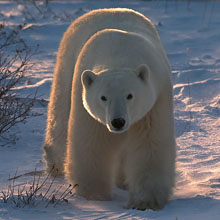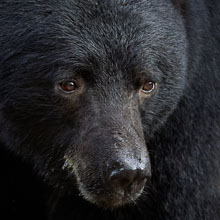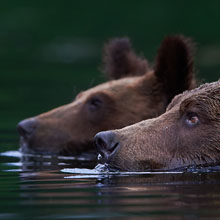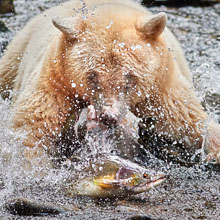Availability: Undetermined - Enquiries?
In the Field
The Fishing Focus. Great Bear Rainforest (central BC coast), Canada. October 1, 2016.
I captured this portrait of a fishing Black Bear during one of my annual "Into the Great Bear Rainforest" photo tours in the autumn of 2016. At the time this very healthy-looking bear was making its way down a salmon stream and stopping every few minutes to stare into the water looking for spawning pink salmon. Often the bear would absolutely freeze and remain completely still for several seconds (sometimes up to half a minute) and watch for any "suspicious" movement or ripples on the surface - just like shown here! This bear was definitely no rookie at fishing - whenever it did see a salmon and rushed at the unfortunate fish it invariably ended up with a tasty salmon in its mouth!
We were in a very low-light situation when I shot this image and, at the time, I had a Nikkor 500mm f4E in my hands. Given the very low light and the focal length of the lens I was using, I knew that to get the shot I would have to do two things that put the quality of the image at risk - I had to stop down (to have enough DoF to ensure the bear's entire head was in sharp focus) and I had to "gamble" on using a reasonably slow shutter speed. This meant I ended up with an unenviable balance of exposure variables that, when combined with the 500mm lens I was hand-holding, wasn't particularly conducive to getting a quality shot: 1/250s @ f8 and ISO 12,800!
Since we entered the digital age of photography (and the cost of film went away!) I've adopted a "heck, why not try it?" attitude when shooting images that are "iffy". Since acquiring a Nikon D5 and carefully assessing the quality of the output at various ISO's (and under a host of different scene types) I've found myself more open than ever to allowing the ISO drift up to almost stratospheric levels. But, I have to say that when I shot this image at 1/250s and ISO 12,800 I was definitely thinking it would be relegated to the trash bin. And I was definitely happy I was very wrong!
Fully assessing a given DSLR's actual ISO performance in a field setting (and deciding how high of an ISO you can use for your own images) is a tough thing to do. My experience is that camera-makers like Canon and Nikon know that ISO performance over a variety of scene types and shooting conditions can't be captured by a single numerical score. Both colour and luminance noise (and how they vary with ISO) play a role (of course), but so do many other variables, like Dynamic Range, Tonal Range, Colour Depth, and more. After shooting with the Nikon D5 for several months (and getting some great shots at some pretty crazy ISO's) I almost fell off my chair laughing when I saw Dxomark.com had awarded the D5 with lowest score in "Low Light Performance" since the Nikon D3. Whatever Dxomark is inputting into the algorithm to come up with that single numerical score for ISO performance has almost no correlation with the ISO performance you experience in the field. In my view - after shooting ALL Nikon flagship cameras since the D2x - is that the D5 is truly the "King of Darkness".
Here's a larger (2400 pixel) version of this very serious and formal looking bear for your perusal:
• The Fishing Focus: Download 2400 pixel image (JPEG: 1.4 MB)
ADDITIONAL NOTES:
1. This image - in all resolutions - is protected by copyright. I'm fine with personal uses of them (including use as desktop backgrounds or screensavers on your own computer), but unauthorized commercial use of the image is prohibited by law. Thanks in advance for respecting my copyright!
2. This image was captured during one of my autumn "Into the Great Bear Rainforest" photo tours in 2016. Each year I offer trips into two different parts of the Great Bear Rainforest as well as one to photograph marine mammals and oceanscapes near the northern tip of Vancouver Island. And, in selected years, I also offer photo tours to additional locations to capture other highly sought-after subjects, such as various boreal owl species, fishing grizzlies, and more. Details about these trips can be found on the Photo Tours page of this website.
3. Like all wildlife images on this website, the subject(s) is/are fully wild and completely unconstrained. Besides the potential impact of my/our presence, nothing has been done to intentionally alter or affect the ongoing behavior of the subject and, of course, there has been no use of any form of bait or other form of wildlife attractants (including vocalizations).
Behind the Camera
The Fishing Focus. Great Bear Rainforest (central BC coast), Canada. October 1, 2016.
Digital Capture; Compressed RAW (NEF) 14-bit format; ISO 12,800.
Nikon D5 paired with Nikkor 500mm f4E VR. Hand-held. VR on and in "Sport" mode.
1/250s @ f8; -1.33 stop compensation from "recommended" matrix-metered exposure setting.
At the Computer
The Fishing Focus. Great Bear Rainforest (central BC coast), Canada. October 1, 2016.
RAW Conversion to 16-bit TIFF using Phase One's Capture One Pro 9.3. Four raw variants (different versions of a single raw capture) processed, with the variants differing in exposure settings (1.0 stop total difference between the variants), shadow/highlight retrieval settings, and in noise reduction settings.
Further digital corrections on resulting 16-bit TIFF files using Adobe's Photoshop CC 2015 and Light Crafts Lightzone. Photoshop adjustments included compositing (blending) of the four output files from the raw converter, minor exposure and colour saturation tweaks, and final selective sharpening for web output. Final tone-tweaking performed using LightZone's "tonemapper" tool.
Conservation
The Fishing Focus. Great Bear Rainforest (central BC coast), Canada. October 1, 2016.
Ten percent of the revenue generated by this image will be donated to Raincoast*.
Species Status in Canada**: Not currently listed as Threatened or Endangered.
This black bear is a member of the subspecies "Kermodei" (Ursus americana kermodei). This subspecies is unique in that the population is characterized by having an unusually high proportion of a recessive gene that produces white coat colour (found on the "Spirit Bears"). Because the Black Bear is not considered under threat as a species, both the Kermodei subspecies and the very rare Spirit Bear suffer from having the same conservation designation (it should be acknowledged that in British Columbia - the jurisdiction of greatest Spirit Bear abundance - hunting of these white-coated bears is not permitted). For reasons that are not fully understood, the Spirit Bear occurs with greater frequency in a relatively small geographic area within The Great Bear Rainforest of the central and northern coast of British Columbia. In this area 10 to 30% of the bears possess white coats. Many of the black-coloured Black Bears in this region carry the gene for white coats, so allowing hunting of ANY Black Bears in this region can reduce the frequency of the gene for white coats. Thus, to protect the Spirit Bear, it is necessary to prohibit the hunting of ALL Black Bears in this region. And, very unfortunately, the globally unique ecosystem that contains the Spirit Bear is under development pressure, especially from the forestry industry. If this unique environment is altered, we may lose the wonderful genetic anomaly known as the Spirit Bear forever.
*The Raincoast Conservation Society (and Foundation) is an effective and efficient organization that has been fighting for protection of this unique habitat. If you are looking for a meaningful way to contribute to the conservation of this amazing ecosystem, Raincoast will provide maximal "bang" for your conservation dollars.
**as determined by COSEWIC: The Committee on the Status of Endangered Wildlife in Canada












